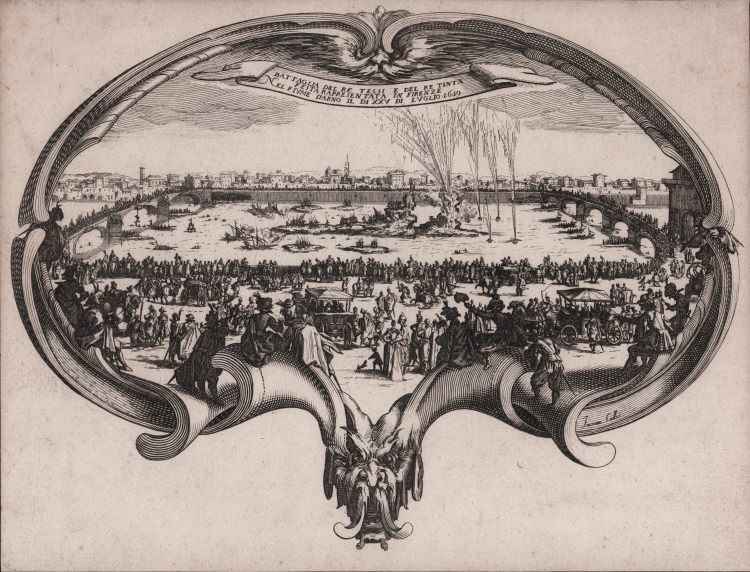




| Reference: | S39601 |
| Author | Anonimo - Scuola Italiana |
| Year: | 1620 ca. |
| Measures: | 303 x 232 mm |



| Reference: | S39601 |
| Author | Anonimo - Scuola Italiana |
| Year: | 1620 ca. |
| Measures: | 303 x 232 mm |
Etching and engraving, 1619 circa, signed on plate Jacomo Callot.
The print is a copy of Jacques Callot's etching known as L'Éventail (The Fan). Example of the first state of two.
Very good example, printed on contemporary paper, in excellent condition.
The engraving depicts the mock naval battle between weavers and dyers, executed on the Arno, in Florence, on the evening of July 25, 1619. It shows the Arno between Ponte alla Carraia and Ponte a Santa Trinità, with a vast view of Florence in the background. Frigates fire at each other before a fireworks display. The view of the festival is enclosed in a scroll whose shape resembles that of Florentine fans. Several figures stand or sit on the scrolls that adorn the scroll; one watches the show through a telescope.
Jacques Callot's rostral (from the type of shape) or fan represents one of the staples in the history not only of the fan but also of Florence. Its shape is definitely beautiful, typical of the taste of the early 17th century. Those who "clash" in the goliardic battle are actually weavers and dyers. On that occasion the contention was actually discursive, and focused on the exchange of speeches, directed toward each other, having for subject matter poems specially composed by Andrea Salvadori, while the practical organization was due to Giulio Parigi. Note, on the left side, a character holding the very fan that is the subject of the engraving.
In the Malmantile racquistato, a famous heroicomic poem by the painter writers Lorenzo Lippi (Florence, 1606-1664), this event is punctually described: “D'altra solenne festa, fatta dalle due Potenze de' Tessitori e de' Tintori, si trova stampata sotto questo titolo […] Alle "Stelle Medicee" v'è l'argomento in prosa, l'introduzione in un Madrigale e ventidue Ottave sopra la disfida. Queste ottave sono di Andrea Salvadori. Furono prima stampate in un cartello e poi in una rosta nella parte anteriore della quale si vedeva la rappresentazione di questa festa, intagliata in rame dal rinomatissimo Jacopo Callotti”.
From this contemporary account, Lippi's work was published posthumously in 1676, we infer that the engraving was made in pendant with Salvadori's verses.
Judging by the large number of contemporary copies - Lieure describes as many as 6 - the work was a huge success.
Lieure 302, copia 2, I/II.
Anonimo - Scuola Italiana
Anonimo - Scuola Italiana